Context 英语语用学 ppt课件
- 格式:ppt
- 大小:1.07 MB
- 文档页数:49
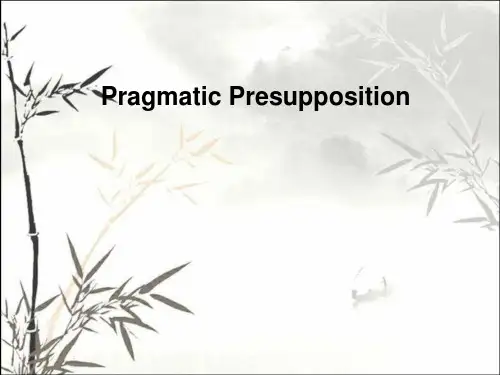
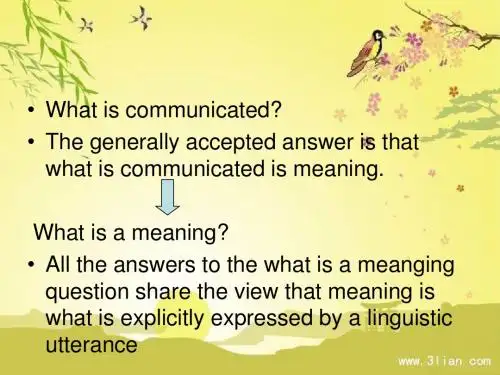

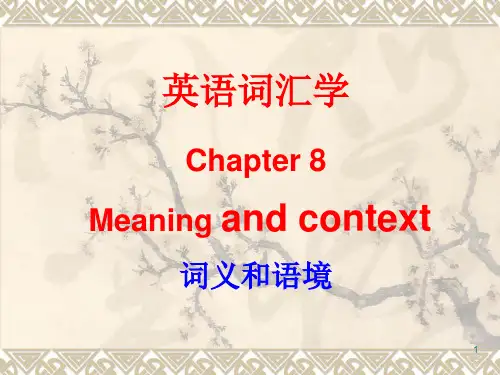
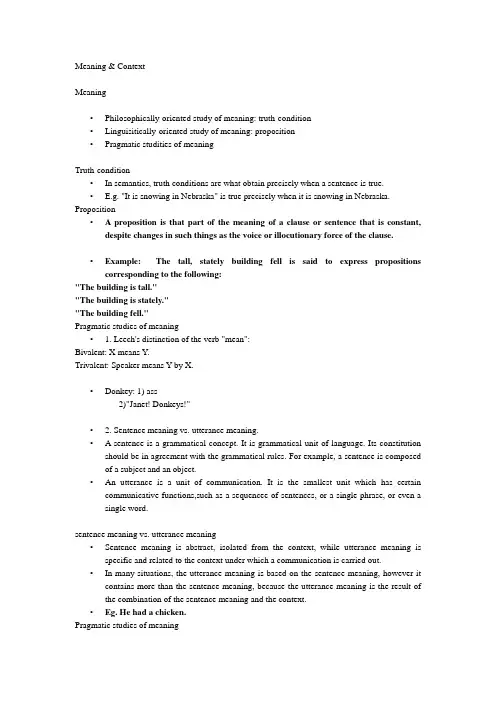
Meaning & ContextMeaning•Philosophically-oriented study of meaning: truth-condition•Linguisitically-oriented study of meaning: proposition•Pragmatic studities of meaningTruth-condition•In semantics, truth conditions are what obtain precisely when a sentence is true.• E.g. "It is snowing in Nebraska" is true precisely when it is snowing in Nebraska. Proposition• A proposition is that part of the meaning of a clause or sentence that is constant, despite changes in such things as the voice or illocutionary force of the clause.•Example: The tall, stately building fell is said to express propositions corresponding to the following:"The building is tall.""The building is stately.""The building fell."Pragmatic studies of meaning• 1. Leech's distinction of the verb "mean":Bivalent: X means Y.Trivalent: Speaker means Y by X.•Donkey: 1) ass2)"Janet! Donkeys!"• 2. Sentence meaning vs. utterance meaning.• A sentence is a grammatical concept. It is grammatical unit of language. Its constitution should be in agreement with the grammatical rules. For example, a sentence is composed of a subject and an object.•An utterance is a unit of communication. It is the smallest unit which has certain communicative functions,such as a sequencee of sentences, or a single phrase, or even a single word.sentence meaning vs. utterance meaning•Sentence meaning is abstract, isolated from the context, while utterance meaning is specific and related to the context under which a communication is carried out.•In many situations, the utterance meaning is based on the sentence meaning, however it contains more than the sentence meaning, because the utterance meaning is the result of the combination of the sentence meaning and the context.•Eg. He had a chicken.Pragmatic studies of meaning•Thomas'analysis of meaning:•1) Abstract meaning (meaning potentials; semantics)•2) Speaker meaning:a. contextual meaning (utterance meaning)b. force (illocutionary force)• E.g. "It's very beautiful."The garden/ fountain is very beautiful.This place is very beautiful.I like this place.Context•Hymes's SPEAKING•Lyons, J: six variables of context•Downes: kinds of contextual information•The dynamic nature of contextHymes's SPEAKING•Setting & scene•Participants•Ends (goals, outcome)•Act sequence•Key (manner)•Instrumentality (channels & forms)•Norms of behaviors•Genre (category)•Setting and Scene•"Setting refers to the time and place of a speech act and, in general, to the physical circumstances".• E.g.The living room in the grandparents' home might be a setting for a family story.•Scene is the "psychological setting" or "cultural definition" of a scene, including characteristics such as range of formality and sense of play or seriousness.• E.g. The family story may be told at a reunion celebrating the grandparents' anniversary.At times, the family would be festive and playful; at other times, serious and commemorative.•Participants•Speaker and audience.•Linguists will make distinctions within these categories; for example, the audience can be distinguished as addressees and other hearers.• E.g. At the family reunion, an aunt might tell a story to the young female relatives, but males, although not addressed, might also hear the narrative•EndsPurposes, goals, and outcomes.E.g. The aunt may tell a story about the grandmother to entertain the audience, teach the young women, and honor the grandmother.•Act SequenceForm and order of the event.E.g. The aunt's story might begin as a response to a toast to the grandmother. The story's plot and development would have a sequence structured by the aunt. Possibly there would be a collaborative interruption during the telling. Finally, the group might applaud the tale and move onto another subject or activity•KeyClues that establish the "tone, manner, or spirit" of the speech act.E.g. The aunt might imitate the grandmother's voice and gestures in a playful way, or she might address the group in a serious voice emphasizing the sincerity and respect of the praise the story expresses.•InstrumentalitiesForms and styles of speech.E.g.The aunt might speak in a casual register with many dialect features or might use a more formal register and careful grammatically "standard" forms.•NormsSocial rules governing the event and the participants' actions and reaction.E.g. In a playful story by the aunt, the norms might allow many audience interruptions and collaboration, or possibly those interruptions might be limited to participation by older females. A serious, formal story by the aunt might call for attention to her and no interruptions as norms.•Genre The kind of speech act or event.E.g.The aunt might tell a character anecdote about the grandmother for entertainment, or an exemplum as moral instruction. Different disciplines develop terms for kinds of speech acts, and speech communities sometimes have their own terms for types.Lyons, J: six variables of context•(1) Each of the participants must know his role and status.•(2) The participants must know where they are in space and time.•(3) The participants must be able to categorize the situation in terms of its degree of formality.•(4) The participants must know what medium is appropriate to the situation.•(5) The participants must know how to make their utterances appropriate to the subject-matter and the importance of subject-matter as a determinant in the selection of one dialect or one language rather than another.•(6) The participants must know how to make their utterance appropriate to the province or domain to which the situation belongs.Downes: kinds of contextual information• 1. background knowledge:1) Knowledge of the language2) Meta-conversational rules, norms, conventions3) Participants' biographies4) Metasocial rules, norms, conventions5) The encyclopedia• 2. Mutual knowledge•Each participant's knowledge that the other knows that P, inferred on some basis.• 3. Context of utterance1) previous utterances in same conversation2) immediate setting of speech3) previous conversation of participants何兆熊--语境知识,1989The dynamic nature of context• 1. Context is a dynamic and changing notion instead of static and prefixed.• 2. Context can be manipulable or negotiable.An illustration of the interactive function of context•Brenda:I'm pregnant... and it's your fault.•Brenda: I told you to be careful...•Arthur: How do you know?•Brenda: I'm twelve days late.•Arthur: How do you know it's mine?•Brenda: I ain't done owt like that with Jack for a couple of months or more.•Arthur: Well, have yer tried owt? Took owt I mean?•Brenda: Yes, took pills but they didn't work.From "Language and Society" (Downes, w. 1984)Functions of Context•Have you eaten? (吃过了吗?)•Context 1: meet on the way--greeting.•Context 2: with cakes at hand -- inviting.•Context 3: S visits L for the shopping arrangement at 10 am -- urging.The same utterance in different contexts can mean differently and have different forces.Functions of Context-- from the speaker's perspective• 1. determine the content according to the communicative goals. (ends)• 2. determine the mode of speaking according to the communicative setting. How detailed? How polite? How formal?How loud?• 3. determine the communicative channel according to the conditions.Oral or written? Prepared or improvised?• 1. determine the reference assignment.Do you like this?Have you finished the book?• 2. disambiguationFlying planes can be dangerous.Can you speak English?• 3. semantic enrichment.•It will take some time to repair your watch.。
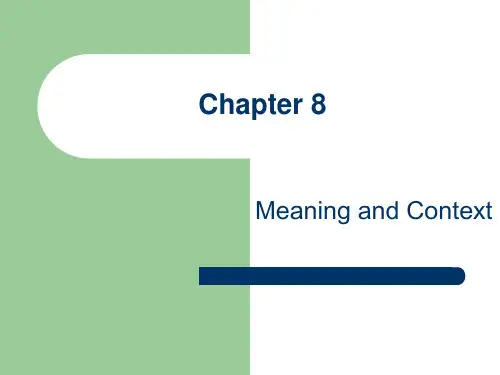
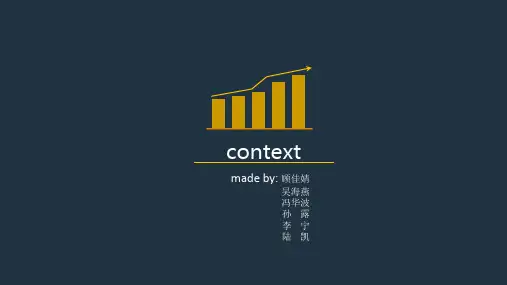
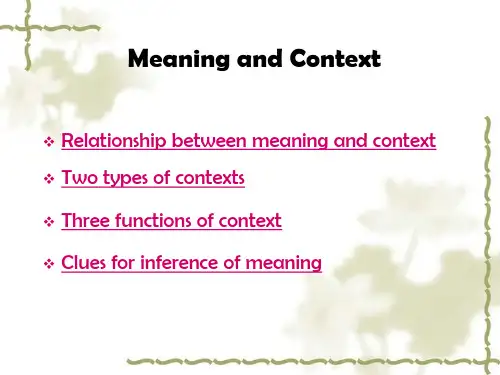
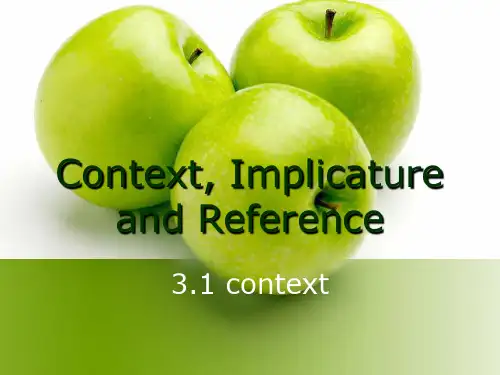


语用学课件整理稿(英文)What is pragmatics?Pragmatics is a systematic way of explaining language use in context [Context is generally considered as constituted by the knowledge [knowledge of the language they use, knowledge of what has been said before, knowledge about the world in general, knowledge about the specific situation in which linguistic communication is taking place, and knowledge about each other) shared by the speaker and the hearer.]It seeks to explain aspects of meaning which cannot be found in the plain sense of words or structures, as explained by semantics. As a field of language study, pragmatics is fairly new. Its origins lie in philosophy of language and the American philosophical school of pragmatism. As a discipline within language science, its roots lie in the work of (Herbert) Paul Grice on conversational implicature and the cooperative principle, and on the work of Stephen Levinson, Penelope Brown and Geoff Leech on politeness. Pragmatics is a subdiscipline of linguistics developed from different linguistics, philosophical and sociological traditions that studies the relationship between natural language expressions and their uses in specific situations. The term pragmatics comes from Morris? (1938) general theory of signs: in this semiotic model (semioti cs), pragmatics refers to the relationship of the sign to the sign user. The distinction between pragmatics and semantics, both of which investigate different aspects of linguistic meaning, is even less clear-cut. While semantics is concerned with the literal and contextually non-variable meaning of linguistic expressions or with the contextually non-variable side of the truth conditions of propositions or sentences, pragmatics dealswith the function of linguistic utterances and the propositions that are expressed by them, depending upon their use in specific situations (pragmatics concentrates on those aspects of meaning that cannot be predicated by linguistic knowledge alone and takes into account knowledge about the physical and social world).Distinction between pragmatics and semantics1. same:linguistic studies of meaning2. differenceSemantics is concerned with the literal and contextually non-variable meaning of linguistic expressions or with the contextually non-variable side of the truth conditions of propositions or sentencespragmatics deals with the function of linguistic utterances and the propositions that are expressed by them, depending upon their use in specific situations.Sentence meaning v. utterance meaningIf we take it as a grammatical unit and consider it as a self-contained unit in isolation, then we treat it as a sentence. Sentence means a unit of speech constructed according to language-dependent rules, which is relatively complete and independent in respect to content, grammatical structure, and intonation.If we take it as something a speaker utters in a certain situation with a certain purpose, then we are treating it as an utterance. Utterance means a string of sounds or written symbols produced by a speaker between two pauses. An utterance can consist of a single word or several sentences.Meaning of a sentence is abstract, and de-contextualized.Meaning of an utterance is concrete, and contextualized.Utterance is based on sentence meaning; it is the realization of the abstract meaning of a sentence in a real situation of communication, or simply in a context.Summary●Language meaning can be analyzed at several levels.●Semantics concentrates o n the meaning that comes from linguistic knowledge, whilepragmatics concentrates on those aspects of meaning that cannot be predicted by linguistic knowledge alone and takes into account our knowledge about the physical and social world.●The focus of pragmatics analysis is on the meaning of speakers? utterances rather thanon the meaning of words or sentences.Utterances need not consist of complete sentences. Each utterance is a unique physical event created at a particular point in time for a particular communicative purpose.What does pragmatics mainly include?The lack of a clear consensus appears in the way that no two published accounts list the same categories of pragmatics in quite the same order. But among the things you should know about are:DeixisSpeech actsPresupposition and entailmentCooperation and implicatureRelevancePoliteness principleDeixisDeixis:The way in which the reference of certain elements ina sentence is determined in relation to a specific speaker and addressee and a specific time and place of utterance.Deictic expressions(指示结构)include such lexemes as:Personal or possessive pronouns (所有格代名词)(I/you/mine/yours),Demonstrative pronouns (this/that),(Spatial/temporal) adverbs (here/there/now),Other pro-forms(替代词)(so/do),Personal or possessive adjectives (my/your),Demonstrative adjectives(指示形容词)(this/that) ,Articles (the).Pro-forms:(替代词)forms which can serve as replacements for different elements in a sentence.A: I hope you can come.B: I hope so.A: Mary is in London.B: John is there too.We invited Mary and John to eat with us because we liked them.A: I like coffee.B: We do too.Two kinds of usages of deixisGestural usage(手势型的用法): with the help of gestures, with some physical indication of the referent (e.g. direction of gaze), completely context-dependent.He is not the president. He is. He?s the secretary.Symbolic usage(象征型的用法): with the help of contexts (Gestures are not necessary.We should know the time, space, participants, etc. The communicators are not necessarily present.)This city is highly congested.Non-deictic usages of deixisEndophoric reference(文内照应): the entity(实体)the deixis refers to exists in the sentence/ passage, the purpose of the use of deixis is for cohesion(粘连). Mostly third person (single, plural) is used for endophoric reference.e.g.: Peter studies Japanese. He wishes to go to Japan some day.We were led into a big room. Here, it was said, Ford produced his first car.Exophoric reference(文外照应): the entity the deixis refers to does not exist, and the referential meaning can be judged from the context. Mostly first and second person (single, plural) is used for exophoric reference.e.g.: He?s not the president. He is. He?s the secretary.You can come with me if you like.Some deixis belongs neither to endophoric reference nor to exophoric reference, it doesn?t exist in a context or discourse(文篇), for example “we”, “you” which do not refer to specific persons; “here”, “there” used in some set expressions, e.g. “Here we are”,”There wego”.gestural usageexophoric referenceDeixis symbolic usageendophoric reference: cohensionCategories of Deixis2.3.1 Person DeixisDeixis depending on the identity of speakers, addressees, and others.1) The basic grammatical distinctions are the categories of first, second and third person ——speaker inclusion, addressee inclusion, speaker and addressee inclusion. [Some pronominal systems exhibit as many as fifteen basic pronouns (ignoring honorific alternates) by superimposing distinctions based on plurality, gender and so on.]2) The first and second person pronouns are usually used in exophoric reference; the third person pronouns (single and plural) are usually used in endophoric reference.e.g. You can come with me if you like.You can never tell what sex some teenagers are nowadays.John came in and he lit a fire.3) Third is quite unlike first and second person, in that it does not correspond to any specific participant-role in the speech event.4)Vocatives(呼语)can be divided into calls, or summonses(呼唤语)and addresses (称呼语). The distinction is precisely that between gestural and symbolic usages.Summonses are naturally untterance-initial, addresses are parenthetical and can occur in the sorts of locations that parentheticals can occupy.E.g Hey you, you just scratched my car with your Frisbee. (calls)The truth is, Madam, nothing is as good as nowadays. (addresses)4) It is common in many languages for mother to say to father, in the presence of little Billiesomething like “Can Billie have an ice-cream, Daddy?” taking the view, for the purpose of vocative selection, of the audience. These distinctions make it important that we do notconfuse the categories of addressee and hearer.5) In many languages, there are two first person “plural” pronouns corresponding to“we-inclusive-of addressee” (包括谈话对方)and “we-exclusive-of addressee”. (不包括谈话对方)E.g. Let us know the time of your arrival. (exclude the addressee)Let?s go to the cinema. (include the addre ssee)您安心养病吧!我们过几天再来看您。